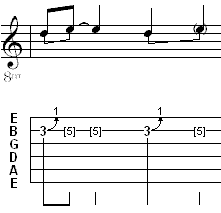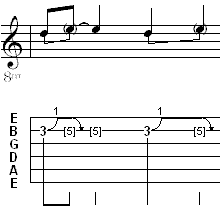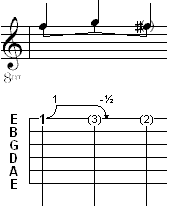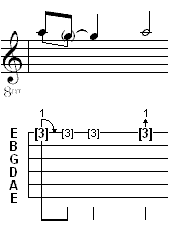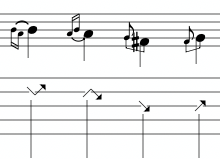Bends
|
A simple bend is created by first entering two notes on the same string. The first note is the initial pitch and the second note the pitch to be achieved by the bend. Highlight the first note and apply the bend effect. A small curved arrow appears to the right of the number on the tab line. The small number at the tip of the arrow indicates the number of whole tones of the bend. There is a two fret, one whole tone, limitation for a bend if the Advanced Option "Extend bends/slides" is not checked. Applying the effect with a note separation greater than two frets will result in playback of the original tone only. It is common practice to set the second note with a dynamic modifier of ppp to indicate that it is not picked. This will also exclude that note from the tab when printed |
The selection of notes dictates the timing of the bend and the amount of sustain. In the first bend at left, the pitch change will occur over the duration of the first eighth note and sustain through the tied quarter note. The pitch change in the second bend will be slower, over the duration of the quarter note, and the sustain will be shorter.
The release or bend-release effect is created in the same manner as the simple bend and is indicated in the tab as a double, curved arrow. Again the small number represents the number of tones of the bend-release. During playback, the pitch will change to the second note and near the end of the sustain, return to the pitch of the first note. The limitation and timing considerations of the simple bend also apply to the bend-release |
|
In order to create a more complex bend-release, e.g. a full tone bend followed by an half tone release :
|
|
|
A pre-bend release is the same as a bend except the second note is at a lower pitch than the original note. The prebend release is indicated in the tab as an curved arrow with a number to indicate the number of tones in the release. You can get the first display by selecting the "Variation" combined effect. You can get the second display by combining the bend with a +2 semi-tones pitch change. |
The grace note bend/release is the final bend effect. First enter a note at the desired final fret. Then from the "Grace Note" dialog, activate the Bend/Release effect and enter the number of the fret of origin into the "Position" field, a lower fret number for a bend or a higher fret number for a release. The result will be a small number with a curved line to the left of the note in the tablature and a small grace note in the standard notation. The small number represents the starting fret of the bend, NOT the number of tones. |
|
|
TablEdit emulates the effect of detuning or retuning an open string while playing. The effect is only available for the 5-string banjo. To enter a detune, enter a choke on an open note and use the [<] and [>] keys to give it the desired amplitude. To enter a re-tune, enter a pitch change on an open note and apply a simple choke. For a switch back effect after detuning or retuning, enter the effect normally and select the Variation option. |
|
